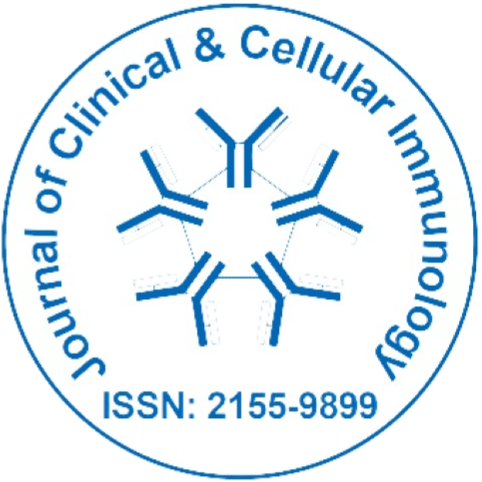
Journal of Clinical and Cellular Immunology
Open Access
ISSN: 2155-9899

ISSN: 2155-9899
Opinion Article - (2025)Volume 16, Issue 2
When we think of immune health, the mind often jumps to the idea of a “strong” immune system capable of warding off infections. But this simplistic notion belies the extraordinary complexity of immunity as a dynamic, multifaceted system. At the cellular level, immune health is not merely about resistance to pathogens, but about balance, adaptability, and context-specific responses. Immune cells are constantly navigating a delicate equilibrium between activation and tolerance, inflammation and repair, surveillance and restraint.
Recent advances in immunology have uncovered that immune cells exhibit remarkable functional plasticity. Rather than fixed roles, cells such as T lymphocytes, macrophages, and dendritic cells can transition between phenotypes depending on environmental cues, metabolic states, and epigenetic modifications. For instance, macrophages, often seen as frontline defenders, can switch from pro-inflammatory to anti-inflammatory states to support tissue repair. Similarly, regulatory T cells (Tregs), which suppress excessive immune responses, can modify their function based on tissue context or inflammatory signals.
This plasticity is essential to maintaining immune health, enabling the system to adapt to diverse challenges without tipping into chronic inflammation or autoimmunity. Immune dysregulation often arises not from a lack of immune cells, but from failures in this delicate balancing act. For example, chronic inflammatory diseases such as rheumatoid arthritis or inflammatory bowel disease are characterized by immune cells locked into a persistent inflammatory state, failing to recalibrate properly.
Furthermore, the emerging field of trained immunity has revealed that innate immune cells can “remember” past encounters, adjusting their responsiveness based on previous stimuli through epigenetic and metabolic rewiring. This challenges the classical dogma that only adaptive immunity holds memory, expanding the cellular basis of immune health to include innate components with long-term plasticity.
Understanding these cellular nuances reshapes the definition of immune health from simply “being strong” to being appropriately responsive and adaptable — capable of mounting a sufficient defense without collateral damage.
Clinical perspectives: Towards personalized and contextual immune health
Translating this cellular understanding into clinical practice presents both challenges and opportunities. Historically, clinical assessments of immune health have relied on broad indicators like white blood cell counts, antibody titers, or symptom resolution following infection. These metrics, while useful, offer limited insight into the functional state of the immune system or its ability to maintain homeostasis.
As the complexity of immune plasticity becomes clear, there is a growing need for more nuanced clinical tools that capture immune functionality in real time. Technologies such as single-cell sequencing, high-dimensional flow cytometry, and metabolomics are beginning to reveal immune signatures associated with health or disease at unprecedented resolution. These tools promise to enable clinicians to profile patients’ immune landscapes and tailor interventions based on specific dysfunctions.
In infectious disease, for example, patients may present with identical symptoms but vastly different immune states — some mounting robust, controlled responses, others experiencing dysregulated inflammation leading to severe outcomes. Precision immunoprofiling could guide more targeted therapies, optimizing timing and choice of immunomodulatory drugs.
Similarly, in cancer immunotherapy, understanding the functional plasticity of immune cells within the tumor microenvironment is key to overcoming resistance. Tumors often exploit immune plasticity to create suppressive niches, and therapies that fail to account for this adaptability may be less effective. Personalizing treatment to reshape immune cell states rather than merely activating or suppressing immune function could lead to better outcomes.
Beyond disease, redefining immune health also means appreciating its role in aging, metabolism, and chronic conditions. Immunosenescence — the gradual deterioration of immune function with age — is now recognized as a multifactorial process involving shifts in immune cell composition, function, and metabolic fitness. Clinically, this manifests as increased susceptibility to infections, poor vaccine responses, and higher prevalence of inflammatory diseases in the elderly.
Emerging interventions aimed at restoring immune plasticity, such as metabolic modulators or epigenetic therapies, offer hope for rejuvenating immune health in aging populations. Moreover, lifestyle factors like diet, exercise, sleep, and stress management play critical roles in shaping immune functionality, emphasizing the need for holistic approaches to immune wellness.
Ultimately, redefining immune health requires integrating cellular insights with clinical practice, recognizing immunity as a dynamic and context-dependent phenomenon. This integration will drive more personalized, effective strategies to maintain health, prevent disease, and optimize treatment across the lifespan.
The evolving understanding of immune health from cellular plasticity to clinical complexity marks a new era in immunology. No longer can immune health be viewed as a static attribute or a one-dimensional measure of strength. Instead, it is a fluid state defined by the immune system’s capacity to respond appropriately, adapt to changing environments, and maintain balance over time.
Citation: Luzie E (2025). Redefining Immune Health Through Cellular and Clinical Lenses. J Clin Cell Immunol. 16:759
Received: 28-May-2025, Manuscript No. JCCI-25-38843; Editor assigned: 30-May-2025, Pre QC No. JCCI-25-38843 (PQ); Reviewed: 13-Jun-2025, QC No. JCCI-25-38843; Revised: 20-Jun-2025, Manuscript No. JCCI-25-38843 (R); Published: 27-Jun-2025 , DOI: 10.35248/2155-9899.25.16.759
Copyright: © 2025 Luzie E. This is an open-access article distributed under the terms of the Creative Commons Attribution License, which permits unrestricted use, distribution, and reproduction in any medium, provided the original author and source are credited.